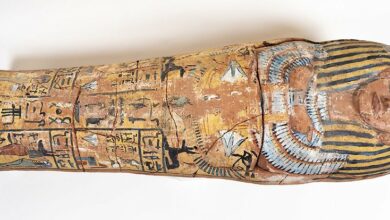
(CNN)–Go to your happy place. Go on, close your eyes and picture it. Take a deep breath and hold it in your mind’s eye for a long, joyful moment.
Already, you feel more relaxed, less stressed, happier. And you aren’t even physically there.
My happy place looks and feels a lot like the common motifs many share: It’s both in nature and insulated from it, like a cabin in the woods. I’m sitting by the golden light of a fireplace in a stuffed chair, under a blanket, with a warm beverage and engrossing book in hand. Music is playing, but it’s slow and quiet. Family and friends are there, too. We’ll play an unhurried card or board game and share funny stories. We’ll eat a delicious meal together. It’s snowing or raining, and we watch the weather unfold, go out in it and then enjoy coming back inside again. I don’t need any other distractions in my happy place. I have everything I need to be fully connected and blissed out.
The kind of experience I’m describing is something of a national pastime in Norway. They even have a word that snugly wraps all these ideas up: “koselig.” The concept is undoubtedly connected to the fact that cold, nature-embracing countries such as Norway, Finland and Denmark have each recently led the list of the happiest countries in the world.
You could roughly translate koselig (pronounced “koosh-lee”), as “coziness,” but that leaves out crucial components of it, like enjoying the company of others and a connection with nature. There’s no direct English translation, but there are regional equivalents such as the Swedish “mys,” the Dutch “gezelligheid” and the most well-known of these, the Danish “hygge.”
Hygge (pronounced “hoo-gah”) has had a moment in the past few years. Books have been written about it, and the word made it into the Oxford Dictionary and was shortlisted for the 2016 word of the year, defined as “a quality of coziness and comfortable conviviality that engenders a feeling of contentment or well-being.”
It’s that well-being part that gives us reason to replicate koselig or hygge, even as the research slowly confirms what those cold, northern happiest countries have known for a long time: Darkness and isolation can be celebrated because they provide the need for their relief. The act of creating our own light and warmth produces peace and contentment.
The case for koselig as a health practice seems obvious. You already know how it feels to be cozy, or in nature, or with friends. By all logic, most Norwegians should be depressed with seasonal affective disorder by their long, dark, isolating winters. Except that many have found the antidote.
There is some research that supports the power of koselig-esque elements, though. We know that social connections give our life purpose, and that is tied directly to longevity. And anything that decrease stress, such as breaks from work, has numerous mental and physical health benefits.
Just being off your phone for long stretches of time calms you down. One study showed how levels of the stress hormone cortisol rise when you’re frequently on your phone. And elevated cortisol is linked to irritability, anxiety, depression, weight gain, increased blood pressure and poor sleep.
The koselig emphasis on nature is also proven to be good for your health. Having a lot of vegetation near your home decreases your odds of dying prematurely by 12%, according to one study. The researchers suggested that the reasons had to do with lower exposure to air pollution and increased social engagement and physical activity that occur in more natural environments.
Another study showed that people who take walks in nature report less repetitive negative thoughts. And a government health service in Scotland is so convinced of the mental and physical health benefits of nature exposure that it is encouraging doctors to give “nature prescriptions” to help treat high blood pressure, anxiety and depression.
Comfort foods (nutritious and otherwise) have proven psychological benefits; one study showed that they can spur feelings of connectedness and reduce loneliness because they are “a cognitive and emotional reminder of others.” Holding a warm beverage, according to a Yale study, promotes feelings of generosity and caring. Warm light (think candles or fire) has been shown to boost creativity, and staring at fire actually induces relaxation and lowers blood pressure.
In something of a koselig experiment, last weekend, my wife, our two young daughters and I hiked 5 miles on the approach to the Appalachian Trail to a place called the Len Foote Hike Inn in Amicalola Falls State Park in Georgia. Surrounded by wilderness, this “cell phone-free” lodge has 20 two-bed “bunkrooms,” a shared bath house, communal dining room and a large, circular game and puzzle room heated by an old iron wood stove. There are no electrical outlets in the rooms. They wake you up in the morning to watch the sun rise over the mountains.
Our hike in was wet and chilly, the trail muddy, but our spirits jovial. We laughed as my daughters tried to eat trail mix with hands wrapped in my spare socks (we forgot gloves). Upon arrival, we ate treats baked in the kitchen with hot chocolate and coffee. After a convivial group dinner across three long tables, most of the guests retired to the game room, where my daughters and I played an epic game of Settlers of Catan with a high school student and her aunt who had flown down from New Hampshire. My wife spent the evening putting together a puzzle of a map of the Appalachian Trail with other folks we just met. No one watched TV on their iPads or even checked their phones.
My kids, like most, have always put a premium on coziness, setting up their rooms or forts to maximize it. They surround themselves in bed with a menagerie of stuffed animals, which sort of checks off nature, community and coziness. The Hike Inn, with its bonhomie, mountain views, wood stoves, games and delicious, communal homemade meals, is the apotheosis of coziness, and it lifted everyone’s spirits to be there.
The next day was bright and cheery, and we headed back down the mountain with our bellies full of eggs, oatmeal, grits and peach spoonbread, served in a skillet.
“I love this place,” my older daughter said with a whole-body conviction. She recognized instinctively how special it is to be together, safe, warm and connected. Something inside her — and all of us — responds instinctively to the gifts of koselig. And I intend to keep seeking it out.
This essay is part of a column called The Wisdom Project by David Allan, editorial director of CNN Health and Wellness. The series is on applying to one’s life the wisdom and philosophy found everywhere, from ancient texts to pop culture. You can follow David at @davidgallan. Don’t miss another Wisdom Project column; subscribe here.
By David G. Allan, CNN




